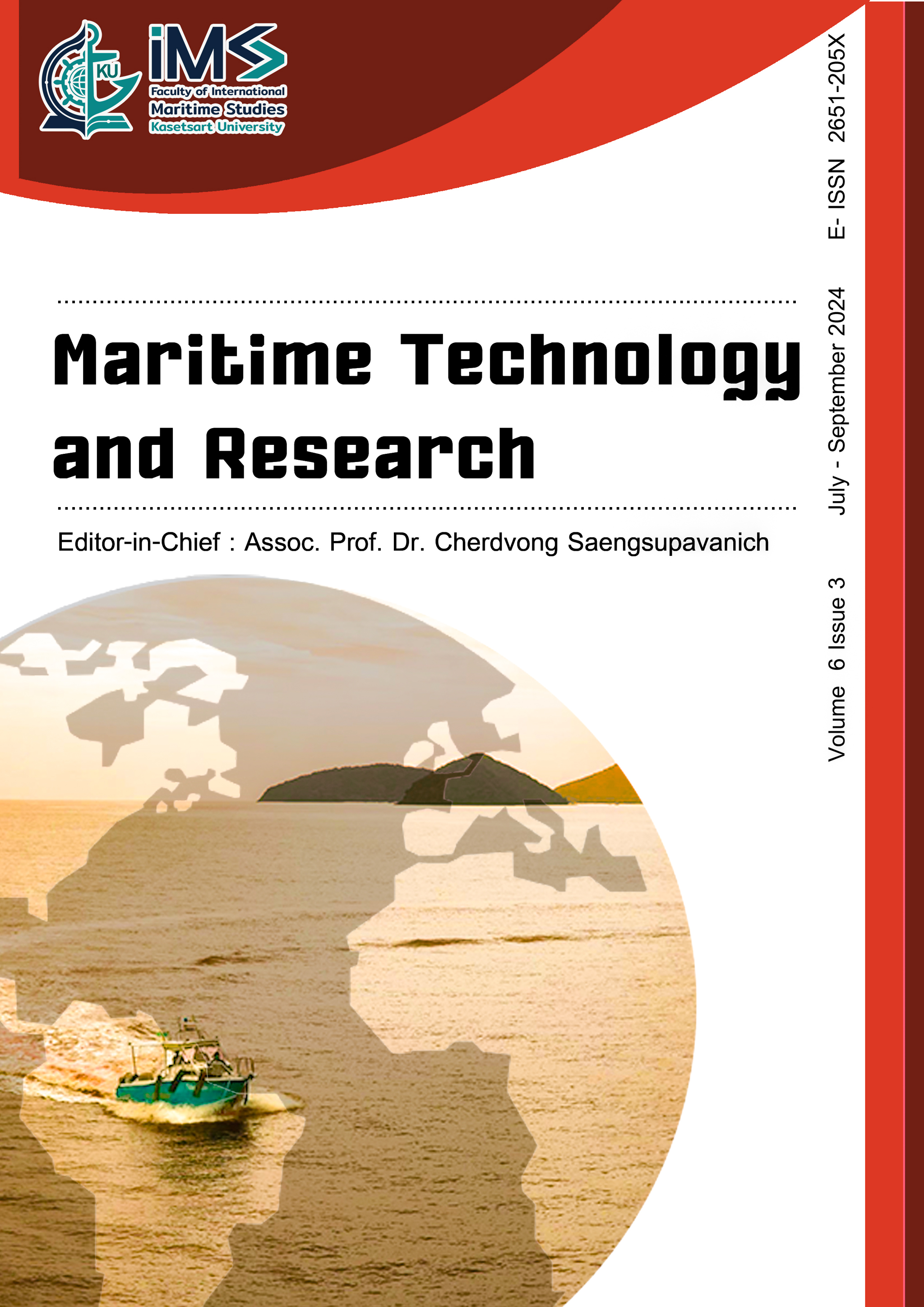A customized drone for ocean and atmospheric measurements and its performances
DOI:
https://doi.org/10.33175/mtr.2024.267638Keywords:
Unmanned arial vehicle, Hexacopter, Ocean data collection, Sea water sampler, LiDAR, Marine applications.Abstract
Drones- Unmanned Aerial vehicles (UAVs)- have become more significant across the world for a wide range of commercial and terrestrial defense applications in recent years. The National Institute of Ocean Technology (NIOT)- Ministry of Earth Sciences (MOES)- is exploring UAVs with a specific focus on maritime applications. NIOT has customized a heavy lift category drone, operable in marine environments and capable of withstanding coastal wind conditions of up to 40 kmph. It can lift and carry an instrumentation payload of 10 kg, conduct ocean data collection, and even take seawater samplings. The 10 kg payload of the UAV might hold a Conductivity Temperature Depth (CTD) sensor, a programmable sea water sampler, and a multi-parameter sensor (MPS) for ocean data collections, and a Light Detection and Ranging (LiDAR) device integrated with a high frame rate camera system for coastal mapping and digital elevation model (DEM) developmental applications. The customized hexacopter UAV is capable of withstanding winds of up to 10 m/s and features a waterproof IPX7 thruster with a maximum thrust of 153 N per axis. The UAV system is also interfaced with a Global Positioning System (GPS), a barometric pressure sensor, a compass, a highly accurate gyroscope, a 15 MP surveillance camera, and an accelerometer sensor connected to a reliable cube orange flight controller module with a redundant 32-bit controller through a serial peripheral interface (SPI). The drone structure and frame is composed of carbon fiber composites to provide an excellent weight-to-strength ratio. This paper presents the outcomes of an initial field test, carried out to ensure the drone’s suitability for various marine applications with intended payloads ranging from 5 - 10 kg weight, including coastal demonstrations and ocean data collections performed at Nellore (Andra Pradesh) and Chennai (Tamil Nadu) coastal waters.
------------------------------------------------------------------------------
Cite this article: Rangan, S., Shanmugam, Y., Valluvan, G., Prakash, T. (2024).cA customized drone for ocean and atmospheric measurements and its performances. Maritime Technology and Research, 6(3), 267638. https://doi.org/10.33175/mtr.2024.267638
------------------------------------------------------------------------------
Highlights
- A drone is customised to with stand elevated wind conditions of coastal regions
- Design is fully flexible meeting the ease of transport from one location to other
- Highly stable mechanical design to sustain winds of up to 45 KMPH
- Redundant flight control mechanism is evolved to assure fail safe operations of drone
- Drone built in with redundant GPS module to avoid scenario like NO Geo-reference at any time
- Design is type certified and UIN registered with DGCA - India
References
Adade, R., Aibinu, A. M., Ekumah, B., & Asaana, J. (2021). Unmanned Aerial Vehicle (UAV) applications in coastal zone management: A review. Environmental Monitoring and Assessment, 193(3), 154-158. https://doi.org/10.1007/s10661-021-08949-8
Anderson, K., & Gaston, K. J. (2013). Lightweight unmanned aerial vehicles will revolutionize spatial ecology. Frontiers in Ecology and the Environment, 11(3), 138-146. https://doi.org/10.1890/120150
Colomina, I., & Molina, P. (2014). Unmanned aerial systems for photogrammetry and remote sensing: A review. ISPRS Journal of Photogrammetry and Remote Sensing, 92, 79-97. https://doi.org/10.1016/j.isprsjprs.2014.02.013
Duan, G. J., & Zhang, P. F. (2014). Research on application of UAV for maritime supervision. Journal of Shipping and Ocean Engineering, 4, 322-326.
Gertler, J. (2012). US Unmanned Aerial Systems. Library of Congress Washington DC Congressional Research Service: Washington, DC, USA.
Koparan, C. (2016). Unmanned Aerial Vehicle (UAV)-Assisted Water Sampling. Clemson University.
Mayer, S., Sandvik, A., Jonassen, M. O., & Reuder, J. (2012). Atmospheric profiling with the UAS SUMO: A new perspective for the evaluation of fine-scale atmospheric models. Meteorology and Atmospheric Physics, 116(19), 15-26. https://doi.org/10.1007/s00703-010-0063-2
Merz, T., & Chapman, S. (2011). Autonomous unmanned helicopter system for remote sensing missions in unknown environments. International Archives of the Photogrammetry, Remote Sensing and Spatial Information Sciences, XXXVIII-1/C22, 143-148. https://doi.org/10.5194/isprsarchives-XXXVIII-1-C22-143-2011
Qasim, S. Z., & Sengupta, R. (1988). Some problems of coastal pollution in India. Marine Pollution Bulletin, 19(3), 100-106. https://doi.org/10.1016/0025-326X(88)90704-7
Samudranil, S. (2016). Water pollution in India: Causes, Effects and Solutions. Maps of India.
Srinivasan, R., Gowthaman, V., Tata, S., & Ramadass. G. A. (2022a). Adapting the drone technology for marine applications - A high resolution water quality measurement system using drone - Part A. Journal of the Institute of Marine Engineers, 16(10), 9-15.
Srinivasan, R., Gowthaman, V., Tata, S., & Ramadass. G. A. (2022b). Adapting the drone technology for marine applications - A high resolution water quality measurement system using drone - Part B. Journal of the Institute of Marine Engineers, 16(11), 14-21.
Srinivasan, R., Gowthaman, V., Tata, S., & Ramadass. G. A. (2022c). Adapting the drone technology for marine applications - A high resolution water quality measurement system using drone - Part C. Journal of the Institute of Marine Engineers, 16(12), 23-26.
Warwick, G. (2011). Phantom Eye UAV Readied for Hydrogen Flights. Aerospace Daily.
Weisgerber, M. (2011). USAF Seeks Endurance-Payload Sweet Spot. Graham Warwick, Orion UAS to Demo 120-hr. Endurance.
White, S. M., Schaefer, M., Barfield, P., Cantrell, R., & Watson, G. J. (2022). Cost-benefit analysis of survey methods for assessing intertidal sediment disturbance: A bait collection case study. Journal of Environmental Management, 306, 114386. https://doi.org/10.1016/j.jenvman.2021.114386
Yang, Z., Yu, X., Dedman, S., Rosso, M., Zhu, J., Yang, J., Xia, Y., Tian, Y., Zhang, G., & Wang, J. (2022). UAV remote sensing applications in marine monitoring: Knowledge visualization and review. Science of The Total Environment, 838(1), 155939. https://doi.org/10.1016/j.scitotenv.2022.155939
Yuan, S., Li, Y., Bao, F., Xu, H., Yang, Y., Yan, Q., Zhong, S., Yin, H., Xu, J., Huang, Z., & Lin, J. (2023). Marine environmental monitoring with unmanned vehicle platforms: Present applications and future prospects. Science of The Total Environment, 858(1), 159741. https://doi.org/10.1016/j.scitotenv.2022.159741
Downloads
Published
License
Copyright (c) 2024 Maritime Technology and Research

This work is licensed under a Creative Commons Attribution-NonCommercial-NoDerivatives 4.0 International License.
Copyright: CC BY-NC-ND 4.0








